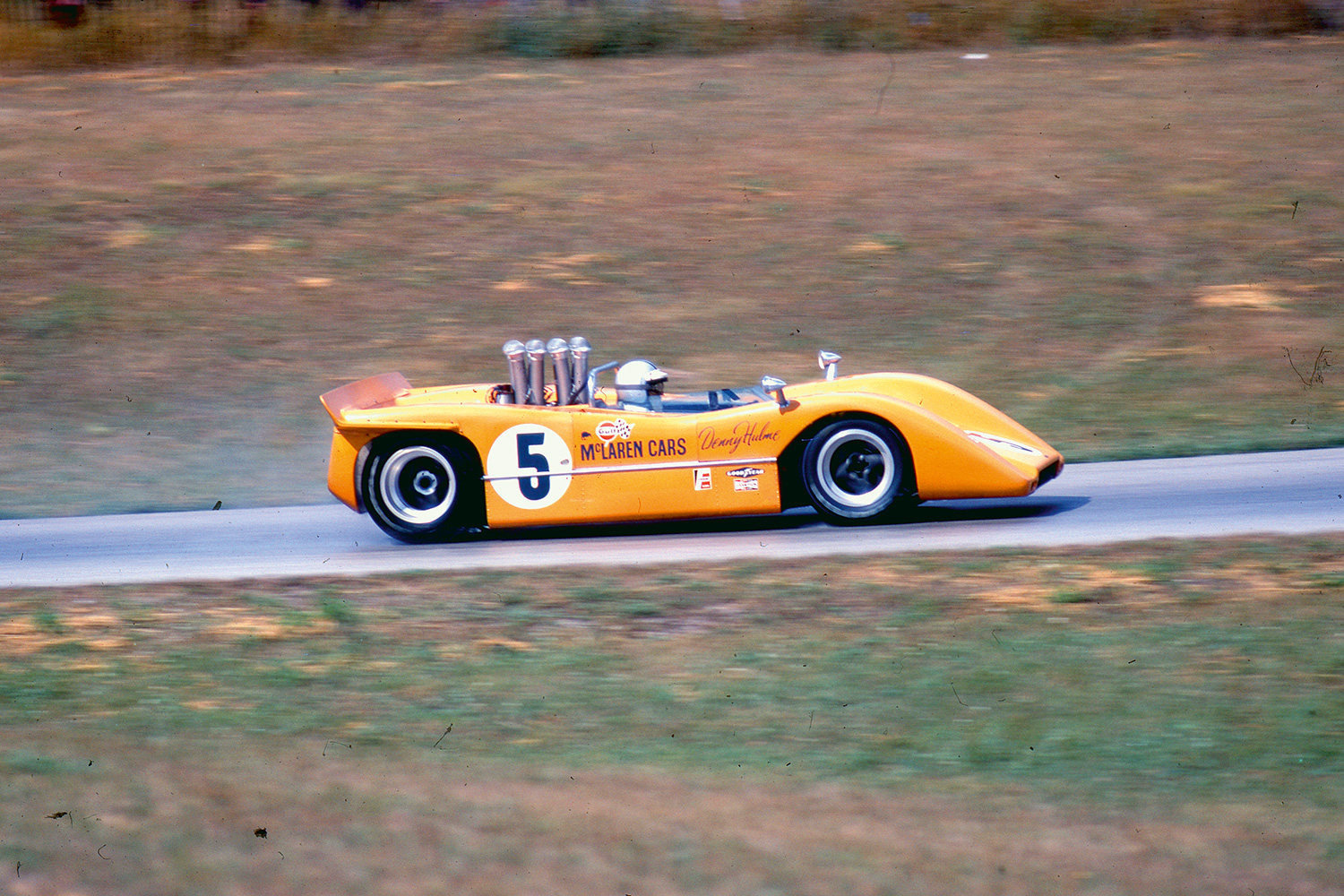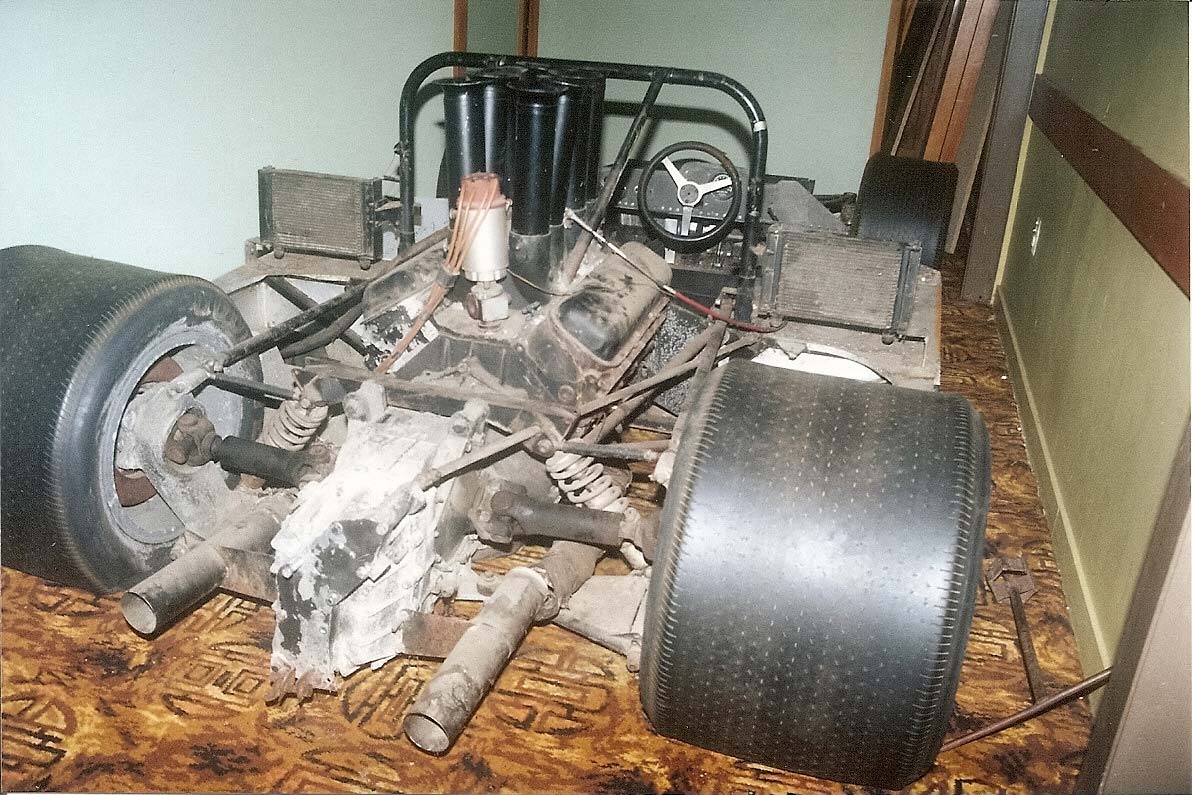Back on December 23 you were enlightened about the famous championship-winning McLaren Can-Am car that came within a whisker of being bulldozed into a South Auckland farm’s rubbish pit only to become the subject of an incredibly fortuitous rescue mission, then a 17-year ownership battle, and finally a transfer of ownership to the Bruce McLaren Trust and the trust’s 15-year, half-million-dollar restoration.
Fast forward to 2014, and with the M8A-2’s restoration completed, another sudden and wildly twisting turn has occurred in the complex and troubled life of the famous old warhorse.

The championship-winning McLaren Can-Am car in action
With M8A-2 finally running, the trust suddenly and painfully comes to realize that owning a car like this — with its inherent fragility, high running costs, and, now, stratospheric value — isn’t the sweet-tasting dish of peaches and cream that was envisaged at the beginning of the restoration. The harsh reality greatly differs from the romantic fantasy, insofar as owning, maintaining, and running the car is costing, and will continue to cost, a lot of money — certainly a great deal more than the income-limited Bruce McLaren Trust can ever hope to afford. The McLaren Can-Am car is worth in the region of 1.5 million dollars, and paying the insurance premium on that figure, even if it’s just for fire and theft, is a strain on the trust’s money jar. Should something happen to the car during its demonstration appearances — whether that be a mechanical failure or, God forbid, a tangle with another car or a barrier — the trust certainly isn’t in any kind of financial position to stitch things back together again.

The M8A-2 prior to restoration
The final push to get the car completed during 2012 and 2013 has put the organization into debt, which makes the chances of facing those formerly mentioned worries of it blowing up or crashing fairly remote because the trust’s debt effectively prevents the car from being able even to do the demonstration runs in the first place — all dressed up and nowhere to go, you might say; or, at least, no way of getting there.
On the other side of the ledger, the trust’s principal objective, and its very reason for being, is to be a living and working memorial to Bruce McLaren and the Bruce McLaren Racing Team. As time has gone by, the trust’s modus operandi has expanded beyond the original scope of just things McLaren to take on a more general role as guardian of New Zealand’s motor racing heritage. To achieve this objective effectively, the trust needs a permanent home from which to operate and in which to house and display the huge inventory of McLaren and other New Zealand motor racing history memorabilia that it has amassed over its relatively short life-span.

The restored M8A-2 under construction
So, harsh realities have conspired to force what would seem, on the surface at least, to be the only viable outcome for the trust, which is to sell its much-beloved M8A-2. The sale of the car will clear the debt that the trust has no other foreseeable means of repaying and that it will otherwise be saddled with indefinitely. The sale will resolve the predicament of the impossibility of running, repairing, and insuring a fragile and expensive car without an income stream from which to do so. It will also enable the trust to buy — with more than two-thirds of the balance of the sale price — a permanent home (effectively, a small museum). The trust is adamant that the money from the sale of M8A-2 will be put aside until the time is right for building, and it won’t be used to run the day-to-day activities of the organization.
As they agonized over their tough decision, trust members were desperately keen for the car to stay in New Zealand. However, no Kiwi buyers could be enticed to part with the necessary $1.5 million or thereabouts, so M8A-2 has been sold overseas. With the contract signed and the deposit now paid, the McLaren will be crossing the Pacific Ocean during the first week of September. The overseas buyer — who at this point wishes to remain anonymous — is considered by the McLaren trustees to be an ideal owner, who will use M8A-2 as it should be used, and who can well afford to fix anything that might go wrong. The trust’s view is that it is better for the car to be out there being raced and being seen, fulfilling the purpose for which it was originally intended, than to be tucked away in a museum. Also, there is a better than reasonable likelihood that the new owner will send the car back to New Zealand to race in our historic racing events.

Amidst all the obvious logic associated with the sale of this national treasure, there’s also a negative flipside, which is that a number of people — members of the Bruce McLaren Trust and non-members alike — are very unhappy with the decision to sell an automotive icon that has such an inseparable connection with New Zealand and our famous racing drivers and engineers, especially when the sale is to an overseas buyer. Many New Zealand motor racing enthusiasts donated, provided sponsorship, or offered discounts to the restoration cause on the assumption that the car would always be owned by the trust and would forever remain within New Zealand. I’m one of those people, so I understand the sentiment that is currently running rampant within the New Zealand historic motor racing scene. Linda and I saw M8A-2 countless times throughout its restoration, and even babysat the almost completed car in our garage for several months a few years ago while restorer Duncan Fox was shifting house and had no
space for it.
There is also discontent among members of the Northern Sports Car Club — the people who rescued the car from being bulldozed into that rubbish hole a little over 30 years ago. They are quick to point out that one of the clauses of the agreement to hand M8A-2 over to the McLaren Trust was that the trust would never sell the car. This has created some bitterness, and understandably so. Conversely, apparently MOTAT and Greeta Hulme both understand the situation in which the trust found itself, and accept that the sale was the only viable solution.

I can remember listening to Duncan Fox at his home one evening just after the trust had taken possession of the car — the late ’90s it must have been —and he was preparing to start the restoration. Duncan’s eyes were alive with enthusiasm and passion, as he told me all about the car and its history. He explained that, like an archeologist, by studying photographs from dozens of different sources with a magnifying glass, he was able to establish the many tiny but important details of M8A-2, and then undertake the world-class restoration with the help of other talented Kiwis, including Mike Roberts and Bruce McTavish. This project wasn’t about the money. Duncan needs to eat and pay the bills like the rest of us, but this job was pure passion — just as it has been for so many New Zealanders who love motor racing, and, in particular, New Zealand’s rich motor racing heritage. So, little wonder that there is a sense of sadness and loss amongst many of us at the decision that has been made.
Personally, I’m a bit on the fence: I’m saddened by the sale — and it would seem that an agreement has been broken — but I understand the situation and I don’t think the trust, if it wants to move forward and meet its principal reasons for being, had any choice but to do what it’s doing. I should imagine that, after everything that the trust has been through in the years between that meeting with MOTAT, the Northern Sports Car Club, and Greeta Hulme back in 1997 and selling the car in 2014, the sale is akin to cutting off an arm or a leg — perhaps even worse than that.
One small consolation that might ease the pain for all of us who mourn the sale of M8A-2, is the upcoming debut of a rare M8B McLaren Can-Am car, which will be campaigned in New Zealand by its South Island owner. Also, thanks to other dedicated McLaren enthusiasts such as Roger Williams and Tony Roberts, we’ll be seeing more of Bruce McLaren’s beautiful beasts taking to the track here.
It seems that this famous old warhorse, which, since its birth in 1968, has been the victim of such extreme highs and lows — from winning a Can-Am title to sitting forlorn and forgotten under a macrocarpa hedge — never stops being surrounded by controversy. Let us wish M8A-2 all the best for the next chapter of her life, and, despite our varying views on the Bruce McLaren Trust’s decision to sell her, be thankful to the Northern Sports Car Club for snatching the car away from the jaws of a shockingly undignified end, and to the Bruce McLaren Trust for its foresight and tenacity in making the spectacular restoration happen. Without those two organizations, there would be no beautiful M8A-2 about which to have these disparate views.




